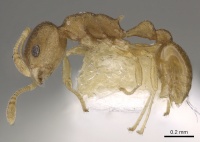Cardiocondyla nana
| Cardiocondyla nana | |
|---|---|

| |
| Scientific classification | |
| Kingdom: | Animalia |
| Phylum: | Arthropoda |
| Class: | Insecta |
| Order: | Hymenoptera |
| Family: | Formicidae |
| Subfamily: | Myrmicinae |
| Tribe: | Crematogastrini |
| Genus: | Cardiocondyla |
| Species: | C. nana |
| Binomial name | |
| Cardiocondyla nana Seifert, 2003 | |
Nothing is known about the biology of Cardiocondyla nana.
Identification
Seifert (2003) - A member of the Cardiocondyla wroughtonii group. Cardiocondyla nana is a species with unique combination of extremely small size, short head, long scape, long spines, very sparse pubescence, peculiar type of microsculpture, and characteristic shape of petiole and postpetiolar sternite.
Seifert (2024) - This species is not to confuse due to extremely small size, the extremely low CL/CW and the large characteristic foveolae on vertex.
Keys including this Species
Distribution
Distribution based on Regional Taxon Lists
Indo-Australian Region: Borneo (type locality), Indonesia, Malaysia.
Distribution based on AntMaps
Distribution based on AntWeb specimens
Check data from AntWeb
Countries Occupied
| Number of countries occupied by this species based on AntWiki Regional Taxon Lists. In general, fewer countries occupied indicates a narrower range, while more countries indicates a more widespread species. |

|
Estimated Abundance
| Relative abundance based on number of AntMaps records per species (this species within the purple bar). Fewer records (to the left) indicates a less abundant/encountered species while more records (to the right) indicates more abundant/encountered species. |

|
Biology
Castes
Nomenclature
The following information is derived from Barry Bolton's Online Catalogue of the Ants of the World.
- nana. Cardiocondyla nana Seifert, 2003a: 276, fig. 54 (w.) BORNEO (Brunei).
- Type-material: holotype worker.
- Type-locality: Brunei: Ulu Temburong N.P., 283 m.T., 22.ii.1982 (M.C.Day).
- Type-depository: BMNH.
- Status as species: Pfeiffer, et al. 2011: 44.
- Distribution: Brunei.
Unless otherwise noted the text for the remainder of this section is reported from the publication that includes the original description.
Description
Worker
Smallest known Cardiocondyla species, CS 366. Head extremely short, CL/CW 1.069. Scape rather long, SL/CS 0.818. Postocular index large, PoOc/CL 0.464. Eyes without any micro setae and small, EYE 0.220. Median third of anterior clypeal margin deeply, median third of occipital margin slightly concave. Frontal carinae immediately caudal of FRS level slightly diverging, FRS/CS 0.266. Anterior clypeus smooth, not shining. Frontal laminae and anteromedian vertex with weak microsculpture, consisting of an irregular mixture of corrugated, foveolate, and carinulate elements. Paramedian and lateral areas of vertex with a unique sculpture: densely-arranged, deeply impressed, and flat-bottomed foveae of 19-23 mm diameter show a well-demarcated central ring of 8-9 mm diameter which is connected with the outer ring through 2-4 very fine microcarinulae (frequently in a characteristic 90° crosswire arrangement, in other foveae the number of microcarinulae may be reduced below 2). Whole lateral area of mesosoma, anterior area of pronotum, and dorsal area of propodeum strongly microreticulate; dorsal area of promesonotum similarly foveate as paramedian vertex. Longitudinal sculpture on whole mesosoma, including metapleural gland bulla, completely absent. Petiole strongly microreticulate, postpetiole shining, very finely microreticulate. Spines long and thin, in profile deviating from longitudinal mesosomal axis by 45°. Metanotal groove deep. Petiole in profile with almost linear (only slightly concave) anterior face and semicircular dorsum. Anterior postpetiolar sternite instead of corners with a strong, curved carina on each side; in frontal view, anterior sternite thus appearing deeply concave. Petiole in dorsal view with rather slender peduncle and almost globular node, which is slightly longer than wide. Postpetiole in dorsal view with a concave anterior margin and convex sides. Surface of 1st gaster tergite shining, with sparser pubescence than in other members of Cardiocondyla wroughtonii group. All body parts light-yellowish.
Type Material
Holotype worker labelled “BRUNEI: Ulu Temburong L.P.-283.m.T. 22.ii.82.MC.Day The Natural History Museum London.
References
- Seifert, B. 2003. The ant genus Cardiocondyla (Insecta: Hymenoptera: Formicidae) - a taxonomic revision of the C. elegans, C. bulgarica, C. batesii, C. nuda, C. shuckardi, C. stambuloffii, C. wroughtonii, C. emeryi, and C. minutior species groups. Annalen des Naturhistorischen Museums in Wien Serie B Botanik und Zoologie. 104:203-338. (page 276, fig. 54 worker described)
- Seifert, B. 2022. The ant genus Cardiocondyla (Hymenoptera: Formicidae): The species groups with Oriental and Australasian origin. Diversity 15, 25 (doi:10.3390/d15010025).
- Seifert, B. 2024. A taxonomic revision of the ants of the Cardiocondyla wroughtonii group (Hymenoptera: Formicidae) with a checklist of the Cardiocondyla species of the world. Soil Organisms 96 (2):113-144. (doi:10.25674/415)
References based on Global Ant Biodiversity Informatics
- Pfeiffer M.; Mezger, D.; Hosoishi, S.; Bakhtiar, E. Y.; Kohout, R. J. 2011. The Formicidae of Borneo (Insecta: Hymenoptera): a preliminary species list. Asian Myrmecology 4:9-58
- Seifert B. 2003. The ant genus Cardiocondyla (Insecta: Hymenoptera: Formicidae) - a taxonomic revision of the C. elegans, C. bulgarica, C. batesii, C. nuda, C. shuckardi, C. stambuloffii, C. wroughtonii, C. emeryi, and C. minutior species groups. Annalen des Naturhistorischen Museums in Wien. B, Botanik, Zoologie 104: 203-338.

